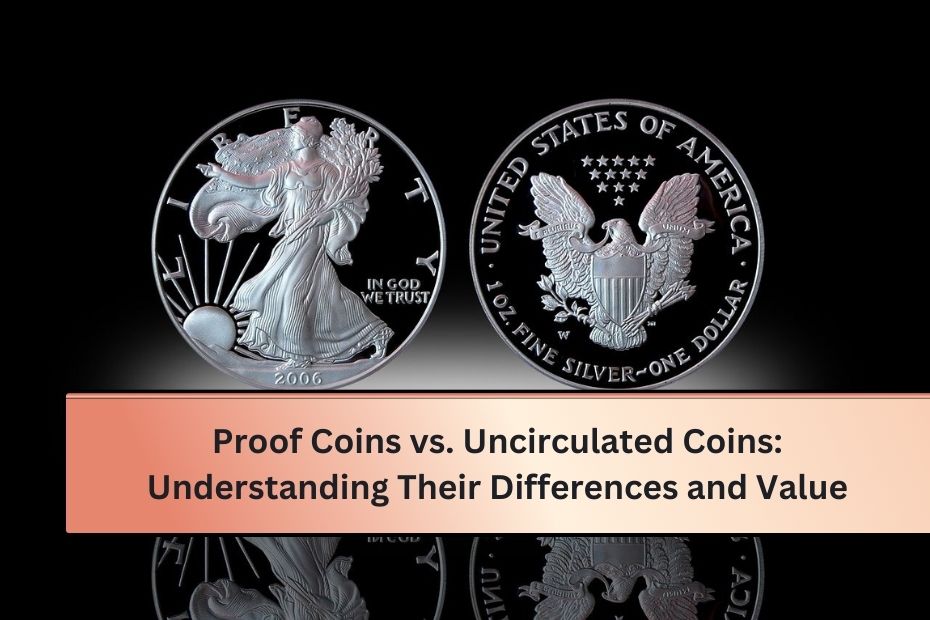When it comes to coin collecting, two popular categories collectors encounter are proof coins and uncirculated coins. While both are never intended to circulate, they differ significantly in their production process, appearance, and value. Understanding the differences between these two types of coins can help collectors make informed choices about their collections. This article explains what proof and uncirculated coins are, highlighting how they are made, their unique qualities, and how they influence their collectibility and value.
What Are Proof Coins?
History and Purpose
Proof coins originated as test pieces to ensure that the die used to strike the coins was working correctly. These coins were created by striking them multiple times to bring out intricate details. In the past, proof coins were made just to confirm the die’s quality before mass production began. Today, however, the purpose has shifted.
Modern Proof Coins
Modern proof coins are no longer just tests. They are produced as high-quality collectible items. Proof coins are struck at least twice and hand-polished, resulting in a mirror-like finish. The background of the coin appears shiny, while the raised details have a matte finish. This high level of craftsmanship makes them highly desirable to collectors.
Collectibility and Value
Proof coins are often sold at a premium because they are considered the finest examples of coinage. Since they are manufactured solely for collectors and not for circulation, they are often packaged in protective cases to preserve their pristine condition. Proof coins can appreciate in value over time, especially when they are part of limited editions or made from precious metals like gold or silver. They also make popular gifts for special occasions, such as holidays or birthdays.
What Are Uncirculated Coins?
Definition and Characteristics
Uncirculated coins, as the name suggests, are coins that have never been in circulation. These coins are produced with the same designs as regular circulating coins but are set aside for collectors. They may have a smoother and shinier appearance than circulated coins, but they do not possess the mirror-like quality of proof coins.
The U.S. Mint and Uncirculated Coins
There has been some confusion around the term “uncirculated” due to changes in marketing by the U.S. Mint. Initially, from 1986 to 2005, the term referred to coins with an uncirculated finish. However, in 2006, the Mint introduced collector-specific uncirculated coins, which are now sold with protective packaging. These coins are also struck on specially burnished blanks, enhancing their appearance compared to regular coins.
Accessibility and Affordability
Uncirculated coins are often more accessible and affordable than proof coins. Since the U.S. Mint typically strikes more uncirculated coins, they are easier to find. This makes them an excellent option for beginners who are starting a coin collection. Despite being less expensive than proof coins, uncirculated coins are still valuable, especially if they are kept in mint condition.
Key Differences Between Proof Coins and Uncirculated Coins
| Feature | Proof Coins | Uncirculated Coins |
|---|---|---|
| Purpose | Collecting, highest quality test | Collecting, never circulated |
| Production Process | Struck multiple times | Struck once |
| Finish | Mirror-like, matte details | Smooth, shiny but less reflective |
| Packaging | Protective packaging | Protective packaging |
| Value | Higher value due to rarity | More affordable, accessible |
Collecting Proof vs Uncirculated Coins
| Aspect | Proof Coins | Uncirculated Coins |
|---|---|---|
| Best for | Serious collectors, gifting | Beginners, affordable collection |
| Appreciation Potential | High, especially in limited runs | Moderate |
| Production Numbers | Lower, often limited editions | Higher production numbers |
| Gift Suitability | Excellent for special occasions | Great for starting collections |
Conclusion
Both proof and uncirculated coins are essential to the world of coin collecting. Proof coins, with their striking appearance and premium quality, are sought after by serious collectors and often command higher prices. Uncirculated coins, on the other hand, are more affordable and accessible, making them an ideal starting point for new collectors. Whether you’re drawn to the mirror-like beauty of proof coins or the shinier yet simpler uncirculated coins, both offer unique opportunities for investment and enjoyment in coin collecting.
FAQ’s
What are proof coins?
Proof coins are high-quality coins struck multiple times with a polished finish, mainly for collectors.
What is the main difference between proof and uncirculated coins?
Proof coins have a mirror-like finish, while uncirculated coins are shinier but less detailed.
Are uncirculated coins valuable?
Yes, uncirculated coins are valuable, especially when kept in mint condition, but they are generally more affordable than proof coins.
Why are proof coins more expensive?
Proof coins are more expensive because they are made with a more detailed process, often in limited quantities, making them rarer and more collectible.
Can I start collecting with uncirculated coins?
Yes, uncirculated coins are an excellent and affordable option for beginners looking to start a coin

